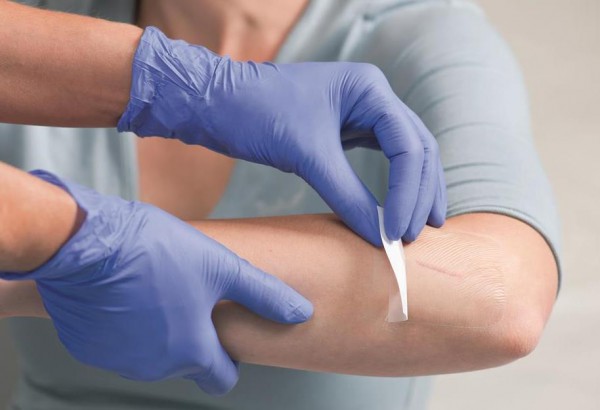Wound dressings form an integral part of wound care. For much of history, it was believed that wounds should be left open to dry out to improve healing. However, a better understanding of normal wound healing physiology through clinical advancement led clinicians to realize the importance of wound dressings in optimizing wound healing. Ever since the concept of moist wound healing was introduced by George Winter, new wound dressings were developed that were able to retain moisture and played an active role in wound healing. Transparent film dressings are one of the earliest wound dressings developed that could maintain wound moisture.
Transparent Film Dressings: An Overview
Transparent film dressings, appropriately named because of their "see-through" appearance, are made up of sheets of polyurethane membrane. These dressings are permeable to water and small molecules but are impermeable to larger molecules such as protein and bacteria. This property makes them ideal for maintaining wound moisture and reducing infection rates.
Transparent film dressings are self-adhesive and can adhere to the wound site without actually sticking to the wound margins. By providing an outer covering, the film dressings allow for a moist environment and epithelial cell migration over the wound surface. This leads to improved wound healing.
One thing to be kept in mind regarding transparent film dressings is that even though they can maintain wound moisture, they do not have any absorptive capacity. This makes them unsuitable for wounds with heavy exudate. In addition, there is a potential for wound maceration due to excessive wound exudate collection. Therefore these dressings need to be changed in a timely manner. Examples of transparent film dressings include Tegaderm, Cutifilm, Blisterfilm, and Bioclusive.
Importance Of Wound Dressing In Wound Healing
The advances in the 20th and 21st centuries have led to the development of wound dressings that can stimulate and proliferate wound healing. Wound care specialists and podiatrists now have a variety of options available to select for their patients. Apart from optimizing moisture in the wound microenvironment, modern wound dressings also play an important role in preventing wound infection, decrease pain associated with wounds, and are also able to provide autolytic debridement.
Even though wound dressings might differ based on their individual properties, there are certain properties that an ideal wound dressing should possess. These include:
- Transparency to allow wound care specialists and podiatrists for easy monitoring of the wound
- Cost-effective and readily available
- Easily adheres to the skin and can fit in inaccessible parts of the body
- Able to maintain a moist wound environment
Benefits of Transparent Film Dressings
There are several benefits of using transparent film dressings in wound care. Some of these are described below:
- Better Visualization: Transparent film dressings allow for better visualization and inspection of the wound. This allows clinicians to better monitor and assess the progress of wound healing.
- Autolytic debridement: Fluid can get collected underneath the transparent film dressings. This wound exudate helps create a moist wound environment and can induce autolytic debridement.
- Decreased Infection: Transparent film dressings provide a protective barrier against external contaminants and bacteria. This helps to reduce the risk of wound infections. As a result, transparent wound film dressings are associated with the fastest healing rates and the lowest risk of infections.
- Protection From Friction: Transparent film dressings also protect from friction and external trauma.
- Secondary Dressings: Transparent films are excellent in providing an additional layer of dressing and can therefore be used as secondary dressings.
Applications of Transparent Film Dressings
Transparent film dressing is most appropriate for wounds with minimal exudate as they lack absorptive capacity. The types of wounds that transparent film dressings can be used for include:
- Superficial wounds
- Minor burns
- Lacerations
- Stage I and II pressure ulcers
- Superficial dermal ulcers
- Infected wounds
In addition, transparent film dressings can also be applied over sutures, central lines, peripherally inserted central lines, and catheter sites.
Important Considerations
Some important considerations should be kept in mind when using transparent film dressings:
- Avoid using film dressings over aging and fragile skin. They are most suitable for healthy skin.
- They should be avoided in small children.
- Film dressings are not recommended for heavy, exudating wounds due to the potential of wound maceration.
- Film dressings need to be changed in a timely manner. These should be removed gently and rough handling should be avoided.
- Read the product instructions carefully as different film dressings might vary in their usage.
- The skin should be cleaned before the application of transparent film dressings.



.webp)

.avif)